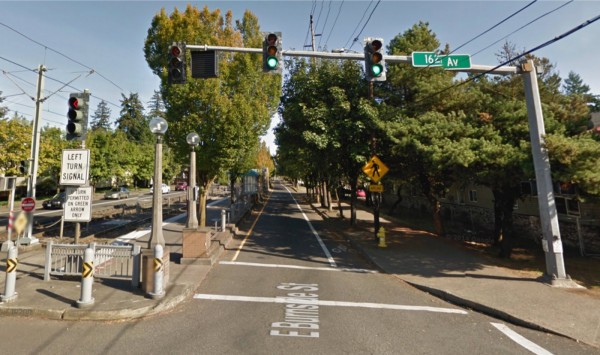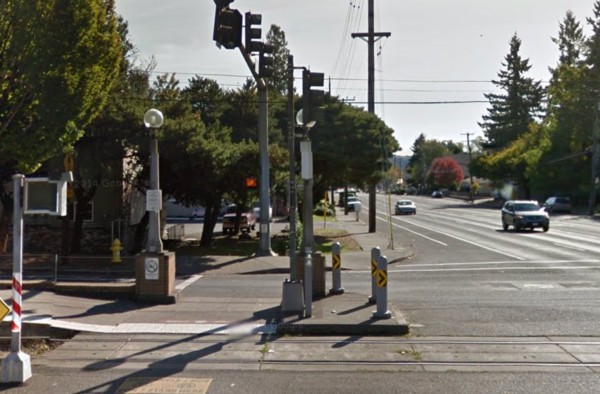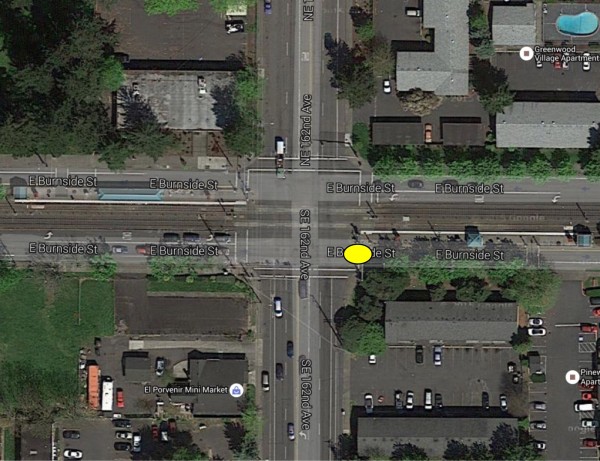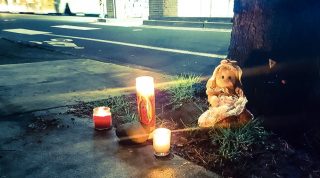
East Portland is once again reeling after the death of a young person who was using the street while not in an automobile. It’s already being called an accident, but there’s reason to think more deeply than that label usually allows.
Just 10 days ago 17-year-old Austin Hrynko died after being hit by a man driving drunk on SE Center Street near Powell Butte. Then yesterday afternoon just three miles north of where Hrynko was hit, 10-year-old Jaafar Shbeb was struck and killed by a woman driving a car as he tried to cross East Burnside.
Yesterday’s tragedy happened just a block or so across the Portland/Gresham border at 162nd. There’s a light rail line in the middle of Burnside at this location which makes the street relatively narrow.
Here’s the view from the crosswalk looking south:
And here’s the aerial view for context:
For the latest update, see the statement below released this morning by the Gresham Police Department:
Horrific Accident Claims Life of Young Boy
East County communities are mourning the loss of a 10-year-old boy, killed yesterday at 4:16 p.m. when he inadvertently stepped into the pathway of a vehicle on Burnside St. The crash was witnessed by a Gresham police officer who happened to be patrolling the area at that time.
Advertisement
Six weeks shy of his eleventh birthday, Jaafar Shbeb was walking south on NE 162nd Ave. with his sister and a friend. The group stopped in the middle of Burnside, in the crosswalk portion of the eastbound MAX platform. Their light was red, as was the crosswalk sign, when Shbeb started to cross the southern portion of the road.
Investigators believe Shbeb was not paying attention to the flow of traffic when he stepped into the roadway and was struck by an eastbound 2008 Nissan Rogue. The car’s driver, Deanna Kurtzbein, 59, of Gresham, had no time to stop or alter her path before hitting Shbeb. Kurtzbein remained at the scene and cooperated fully with the investigation. The crash has been ruled an accident and Kurtzbein is not facing arrest or citation.
Shbeb was attending nearby Glenfair Elementary School. Along with his family, Kurtzbein, and all who witnessed this tragedy, Glenfair is also in mourning. Working with Glenfair’s principal Lisa McDonald, Reynolds School District has extra counselors on site at multiple schools to help friends and schoolmates of Shbeb process this incident. Glenfair has brought a therapy dog to the school and will be talking with students about traffic safety as part of their healing process.
This is gut-wrenching on many levels. I have a 10-year old daughter who walks to school and hangs out on the streets in our neighborhood with her siblings and friends. This morning I watched her and my 13 and 5-year-old all walk down our street to school and my stomach churned as I thought about what Jaafar Shbeb’s family must be going through.
But my sadness won’t stop me from seeing the bigger picture.
The activist in me cringes when authorities call this a “horrible accident.” We constantly preach around here that it’s “crash not accident.” However, I also know how dominant cultural norms work. In this case the off-duty officer who saw what happened, the media who covered it, and everyone else who responded, see the situation through the eyes of the driver, Ms. Kurtzbein. That happens because they, as people who use the roads primarily with an automobile, see themselves in her shoes. Then, when a driver is remorseful, cooperates with police and “remains at the scene,” a strong empathetic impulse takes over. Police agencies also foresee the public outcry that occurs when tragedies like this happen. The empathy combines with this public relations instinct and an inertia builds to establish a narrative that absolves everyone. The entire situation is then engulfed in the halo of sensitivity our culture gives to “horrible accidents.”
“There’s just nothing we can do about it,” is the feeling the powerful cultural norm wants you to have. Do your grieving, it demands, then go back to business as usual.
Sometimes bad things happen to good people and split-second decisions can have life-altering consequences. I get that. But if we dismiss traffic crashes like this as simply an “accident” we do an injustice to victims like Jaafar Shbeb and the others like him that we’ll mourn in the future.
Streets — especially ones with public transit stations adjacent to them! — are places. They are not solely for driving on and moving through. And they are owned by all of us — whether we’re inside or outside of a car. Speed and power does not give one road user any more right to these places than another (“might does not make right” is a phrase I often think of).
Some people are shocked when I tell them I don’t teach my children to fear the streets. Respect, yes. But fear? No. I teach my children to see streets as beautiful places where people can come together to do wonderful, life-affirming things. Yes, we often drive on them; but we also bike on them, play catch on them, do chalk art on them, have parties on them, and so on. And we should all expect that this street — this place — where Jaafar and his friends were hanging out after school should not be so inherently dangerous that a momentary lapse of attention would lead to someone’s death.
Just because we’re told this was an “accident” doesn’t mean we shouldn’t continue to ask questions about our transportation culture. In fact, it should cause us to ask even harder ones and demand even better answers.
— Jonathan Maus, (503) 706-8804 – jonathan@bikeportland.org
BikePortland can’t survive without subscribers. It’s just $10 per month and you can sign up in a few minutes.





